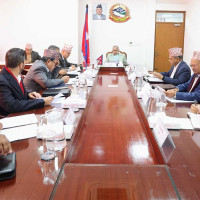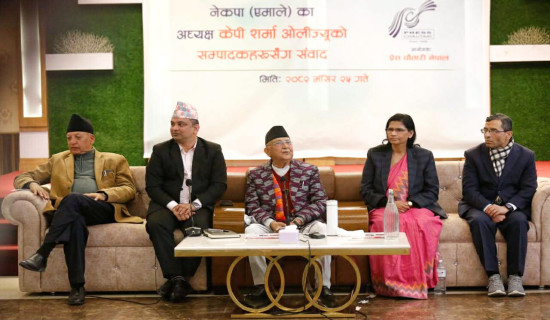- Thursday, 11 December 2025
More rains predicted for upcoming monsoon
Kathmandu, May 14:The upcoming monsoon is forecast to bring more than average rainfall almost across the entire country.
There may be a significant increase in weather events as the rainfall during this monsoon is expected to exceed normal levels, with both maximum and minimum temperatures also predicted to be higher than usual, according to the Department of Hydrology and Meteorology.
If the forecast predicts above-normal rainfall and higher-than-average temperatures, experts suggest that there is likely to be an increase in disasters compared to previous years. Therefore, the country should prepare for disaster preparedness accordingly.
During a programme organised by the National Monsoon Forum at the DHM premises on Monday, the Department’s meteorologist Sudarsan Humagain stated that there is a 35 per cent to 55 per cent chance of above-normal rainfall in most parts of the country during the upcoming monsoon season.
According to Humagain, the north-western part of Sudurpaschim Province, the south-eastern part of Bagmati, the central part of Madhes, and the central and mid-western parts of Koshi Province are expected to receive more rainfall (35.4 per cent to 65.5 per cent higher) than average precipitation this time.
Similarly, the western part of Karnali, the central part of Gandaki, and the north-eastern part of Koshi are likely to experience rainfall exceeding the average by 35 per cent to 45 per cent. The minimum precipitation in most parts of the county is anticipated to be higher than average by 35 per cent to 65 per cent.
Similarly, maximum temperature is forecast to be above 35 per cent to 65 per cent in most parts of the country. However, the western part of Karnali Province, central parts of Gandaki Province, and the north-eastern part of Koshi Province are likely to experience temperatures closer to normal, with an increase of 35 per cent to 45 per cent, Humagain informed.
The minimum temperature is also expected to be higher by 35 percent to 65 per cent in almost all parts of the country, except for a few places in the Sudurpaschim, Gandaki, and Bagmati provinces. In these provinces, the chance of minimum temperature being normal is 35 per cent to 45 per cent normal, he added.
According to Bibhuti Pokharel, chief of the Climate Section under the DHM, the seasonal climate is influenced by various oceanic, atmospheric, terrestrial, glacial, and biological systems. However, there is great uncertainty of weather because of climate change.
The department’s estimate has been prepared based on the climate patterns estimated by the global and regional climate information production centres of the World Meteorological Organisation and the estimates of the South Asian Climate Outlook Platform.
Additionally, while preparing this estimate, the current situation and climate patterns of ENSO (El Niño and Southern Oscillation) in the Eastern Pacific Ocean, and the two polar systems Indian Ocean Dipole (IOD) in the Indian Ocean, which impact Nepal’s monsoon season climate, have been taken into account, Pokharel said.
Currently, ENSO is in a neutral condition, and international models predict the development of La Niña conditions in the upcoming monsoon season. Similarly, the bi-polar sea temperature index in the Indian Ocean is currently neutral and is projected to be positive in the upcoming monsoon season. However, it appears that the existing climate models cannot predict such systems with 100 per cent certainty during seasonal changes, DHM said.
Anil Pokharel, Chief Executive of the National Disaster Risk Reduction and Management Authority (NDRRMA), said that the NDRRMA would initiate disaster preparedness activities following the release of the seasonal forecast by DHM. “Without this forecast, it becomes challenging to anticipate the necessary preparedness measures since we lack insight into the upcoming season and how to initiate preparedness efforts,” he added.
Normally, the typical monsoon onset and withdrawal dates are June 13 and October 2, respectively. However, last year, the monsoon entered eastern Nepal on June 14, taking an additional nine days after its onset to spread throughout the country.
The withdrawal from eastern Nepal occurred on October 15, while in the eastern part of the country, it withdrew on October 6, resulting in a delay of 13 days compared to the usual withdrawal date.
Speaking at the programme, Minister for Energy, Water Resources, and Irrigation Shakti Bahadur Basnet stressed the need for specialised weather forecasting and early disaster warning systems to manage monsoon-related disasters effectively.
He stressed the importance of preparedness and enhancing the early warning system to mitigate impacts.
Minister Basnet pledged to gather feedback for establishing an effective disaster early warning system and emphasised the importance of implementing measures for disaster risk reduction without gaps.
He said that the lack of human and financial resources was a major challenge and advocated for proactive steps for resource management. He also said that the fluctuations in rainfall patterns were due to climate change and highlighted the importance of accurate weather information for agricultural planning.
















